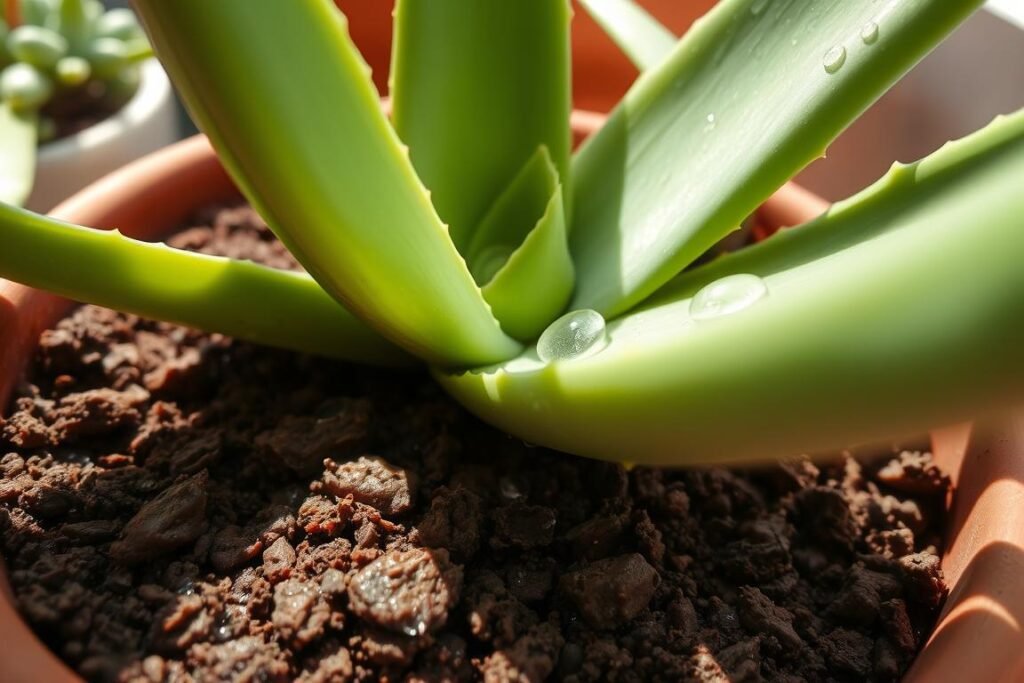I love plants a lot. Aloe vera is one of my favorites. They are tough and green, with healing gel inside. But, it’s hard to know how much water they need.
In this guide, I’ll share what I’ve learned about watering aloe plants. It’s for anyone who loves plants. You’ll learn how to keep your aloe happy and healthy.
Key Takeaways
- Aloe vera plants generally need to be watered once a week for optimal care.
- Overwatering can lead to root rot, while underwatering causes wilting leaves.
- Proper watering techniques involve allowing the soil to dry out before each cycle.
- Aloe vera plants prefer well-draining soil and bright, indirect sunlight.
- Adjusting the watering schedule based on seasonal changes is crucial for aloe vera care.
Understanding Aloe Vera Plant Basics
Aloe vera is a plant that grows well indoors and outdoors. It comes from southern and eastern Africa. It loves bright, indirect sunlight and soil that drains well.
Native Habitat and Growth Characteristics
Aloe vera plants need bright, indirect sunlight or artificial light. They do best in temperatures between 55 and 80°F. They can go without water for a while, needing deep waterings every two weeks.
Benefits and Historical Uses
Aloe vera has been used for thousands of years. Ancient Egyptians, Greeks, and Chinese used it for medicine. Its juice helps with inflammation and detoxifying the body. It also cleans the air you breathe.
Types of Aloe Plants
There are over 420 types of aloe plants. The most common is Aloe Barbadensis, or medicinal aloe. Other favorites include Aloe Crosby’s Prolific and Aloe Ferox. Aloe vera plants rarely bloom indoors because they need special conditions.
It’s hard to grow aloe vera from cuttings. But, you can repot them when their roots get too big or they lean over.
How Much Water Does an Aloe Plant Need
Aloe vera plants love dry air and don’t need much water. They are different from many houseplants. You should water them when the aloe plant soil moisture and watering frequency for aloe plants is right.
Water your aloe about once a week. To see if it needs water, stick your finger into the soil. If the top 3-4 inches are dry, it’s time to water. Water well, then let any extra water drain from the pot.
In winter, when aloe plants sleep, water them less. Half as much as in the growing season is best. Too much water can hurt the roots. So, watch the soil moisture and adjust your watering.

“Proper watering is the key to keeping aloe vera plants healthy and thriving.”
By following these aloe plant soil moisture and watering frequency for aloe plants tips, your aloe will get the right amount of water. This will help it grow well and look beautiful in your home or garden.
Signs of Proper and Improper Watering
Caring for an aloe vera plant needs careful watering. Too little or too much water can cause problems. It’s important to watch for signs of good and bad watering.
Indicators of Underwatering
An underwatered aloe vera plant shows clear signs. Its leaves may look puckered, wilted, and grow slowly. The leaf tips might turn brown and get brittle.
Without enough water, the aloe’s cells lose their plumpness. This makes the plant look shriveled.
Symptoms of Overwatering
An overwatered aloe vera plant has different signs. Its leaves may turn yellow or brown. The cells can get blistered, and the leaves feel soft.
In bad cases, mold can grow in the soil. Too much water can also cause root rot. This makes the plant get worse fast.
Finding the Right Balance
To keep your aloe vera plant healthy, find the right watering balance. Wait until the soil is dry before watering again. Make sure the plant doesn’t sit in water.
When watered right, aloe vera plants have firm, plump leaves. These leaves stand up straight.

Seasonal Watering Requirements
It’s important to water your aloe vera plants right. These drought-tolerant houseplants need different amounts of water at different times.
In the fall and winter, aloe vera plants sleep a lot. They need water less often. Water them half as much as you do in spring and summer. This stops them from getting too wet and sick.
When spring and summer come, water them more. Aloe vera grows fast in warm weather. They need more water to grow new leaves and stems.
If your aloe vera is outside, it might need even more water. Sun and wind can dry out the soil fast. Watch the soil and water it more if needed.
“Aloe vera is a low-maintenance houseplant that can be grown indoors year-round. In the right conditions, aloe plants can last ten to twenty years.”
Knowing when to water your aloe vera helps it stay healthy. This is true whether it’s inside or outside.

Best Practices for Watering Techniques
Watering your aloe plant right is key to its health. You can water from the top or bottom. The goal is to give it the right amount of water.
Top vs. Bottom Watering Methods
Top and bottom watering work well for aloe plants. When watering from the top, avoid getting the leaves wet. This can cause fungus.
For bottom watering, slowly add water to the saucer. Let the soil soak it up from the bottom. This method helps avoid too much water.
Water Quality Considerations
The water you use matters for your aloe plant. If your tap water has lots of minerals, use filtered or distilled water. Aloe plants don’t like the stuff in regular tap water.
Also, use room temperature water. Cold water can shock the roots.
Drainage Requirements
Drainage is crucial for aloe plants. Make sure your pot has holes for water to drain. This stops water from pooling.
For tall pots, add small gravel or pebbles at the bottom. It helps with drainage and air. This keeps your plant healthy.

Follow these tips for watering, water quality, and drainage. Your aloe plant will thank you and grow strong.
Creating the Optimal Growing Environment
Aloe plants love dry air and don’t need much care. They grow best in certain conditions. To help them thrive indoors, you need to create the right space.
They need bright, indirect light. You can use a kitchen window or grow lights if it’s too dark. Keep their temperature between 55°F and 85°F. This is like their home weather.
Home heating can help them. But, don’t put them where it’s cold or where doors and windows open a lot. This can hurt their growth.
Humidity is also key. Aloes like it when it’s not too wet. They do best with about 40% humidity. Make sure air moves well to keep humidity right.
Knowing what aloe plants need helps you make a great indoor space. These plants are easy to care for and love dry air.
| Environmental Factor | Optimal Range for Aloe |
|---|---|
| Sunlight | Bright, indirect |
| Temperature | 55°F to 85°F |
| Humidity | Around 40% relative humidity |
| Air Flow | Avoid drafty areas and frequent air movement |
Follow these tips to make a great home for aloe plants. They will do well in your indoor space.
Soil and Potting Requirements for Proper Water Retention
Getting the soil mix and pot right is key for aloe vera plants. They need soil that drains well but holds moisture. This prevents root rot.
Ideal Soil Mix Components
A good soil mix for aloe vera has different parts. It needs to drain well, breathe, and hold nutrients. Mix 1 part perlite or pumice, 2 parts sand or grit, and 2 parts potting soil with compost.
- Perlite, a light volcanic rock, helps with drainage and air. It lets water out.
- Pumice, another volcanic rock, is full of good stuff. It helps with water, nutrients, and root health.
- Coarse sand or grit makes the soil like aloe vera’s home. It adds air and drains well.
- Compost in the potting soil boosts nutrients. It makes the plant healthier.
Container Selection Tips
Choosing the right pot is also key. Use terra cotta pots for better drainage. They let the soil dry out between waterings. The pot should be wide and deep, and heavy to prevent it from tipping.
Make sure the pot has holes for water to drain. This stops waterlogging and root rot.
| Soil Mix Component | Percentage | Benefit |
|---|---|---|
| Perlite or Pumice | 25% | Improved drainage and aeration |
| Coarse Sand or Grit | 50% | Replicates native soil conditions |
| Potting Soil with Compost | 25% | Nutrient-rich organic matter |
By picking the right soil mix and pot, you help your aloe vera plants thrive. They get the water they need, staying healthy and strong.
Common Watering Mistakes to Avoid
Caring for an aloe vera plant needs careful watering. Overwatering is a big mistake. Aloe vera likes dry air and doesn’t need too much water, especially in winter.
Using soil that holds water is another mistake. This can cause roots to rot. Make sure your aloe has soil that drains well and a pot with holes to avoid water pooling.
- Watering on a set schedule can be bad. Aloe plants store water in their leaves. They can go longer without water than many plants.
- Don’t let your aloe sit in water. This can cause it to get too wet and rot.
Water your aloe less often than other plants. Water once a week in spring and summer. In fall and winter, water every two weeks. Check the soil by sticking your finger in it. If it’s dry, it’s time to water.
Avoid these mistakes and care for your aloe right. This way, it will stay healthy and happy for a long time.
Troubleshooting Water-Related Problems
Keeping the right water balance is key for your aloe plant’s health. If you see water problems, find the cause fast. Here are some tips to help your aloe plant stay healthy.
Overwatering Woes
If your aloe plant has soft or soggy leaves, it’s overwatered. Take it out of the soil and check the roots. If they’re mushy, cut them off.
Let the plant dry for a day or two. Then, put it back in soil that drains well.
Underwatering Concerns
If your aloe’s leaves are droopy, it needs more water. Water it a bit more often. Make sure it gets enough light too.
Watch the soil moisture closely. Adjust how often you water to keep it right.
Environmental Factors
Changes in temperature or drafts can affect your aloe. If leaves turn yellow, it might be because of this. Move the plant to a better spot.
Getting the watering, soil, and environment just right is important. Watch for water problems and fix them fast. This way, your aloe plant will do well for a long time.
| Common Water-Related Issues | Symptoms | Recommended Solutions |
|---|---|---|
| Overwatering | Translucent, soft, or soggy leaves | Remove from soil, inspect roots, trim any discolored or mushy parts, replant in well-draining soil |
| Underwatering | Droopy or puckered leaves | Gradually increase watering frequency, ensure adequate light exposure |
| Environmental Factors | Yellowing leaves | Relocate plant to a more suitable environment with proper temperature and light conditions |
Conclusion
Watering your aloe plant right is key to its health. Knowing how much water it needs helps it stay green and strong. Water it deeply but not too often, letting the soil dry out first.
Change how often you water based on the season and where you live. This keeps your aloe happy and healthy.
Using soil that drains well and containers with holes is important. It stops problems like root rot from too much water. With good care, your aloe will grow well and give you many benefits.
Following these tips helps your aloe plant grow well. It’s good for both new and experienced gardeners. Your aloe will be a great addition to your home or garden.
FAQ
How often should I water my aloe plant?
Water your aloe plant when it needs it, not just on a set day. They usually need water once a week. To check if it’s time, stick your finger into the soil up to your knuckle. If the top 3-4 inches are dry, it’s time to water.
What are the signs of an underwatered aloe plant?
An underwatered aloe plant has puckered, wilting leaves. It also grows slower than usual.
How do I know if I’m overwatering my aloe plant?
Overwatered aloes have yellow or brown leaves. Their leaves may feel squishy. You might also see mold in the soil.
Do aloe plants need more or less water during the winter months?
In fall and winter, aloe plants need less water. Water them about half as much as you do in the growing season.
What type of soil is best for an aloe plant?
Use soil that drains well for aloe plants. You can buy a succulent mix or make your own mix of sand, peat moss, and perlite. Don’t use regular garden soil.
Can I water my aloe plant from the bottom?
Yes, you can water your aloe plant from the top or bottom. Just make sure not to get the leaves wet when watering from the top.
How much sunlight does an aloe plant need?
Aloe plants love bright, indirect sunlight. Place them near a kitchen window or use grow lights if it’s too dark.
What are common mistakes to avoid when watering aloe plants?
Don’t overwater your aloe plant. Also, avoid using soil that doesn’t drain well. And don’t water on a fixed schedule. Water based on what your plant needs.
How can I revive an underwatered aloe plant?
To revive an underwatered plant, start watering it more often. Make sure it gets enough light. If leaves turn yellow or pucker, check for cold temperatures or drafts.
How can I fix an overwatered aloe plant?
If your aloe plant is overwatered, take it out of the wet soil. Let it dry for a day or two. Check for root rot and cut off any bad parts. Then, replant it in dry, well-draining soil. Wait a week before watering again.







